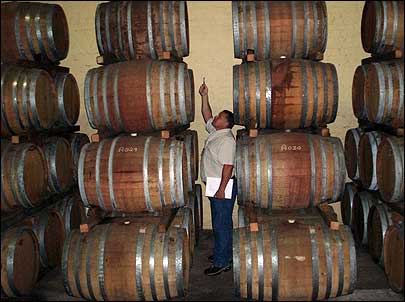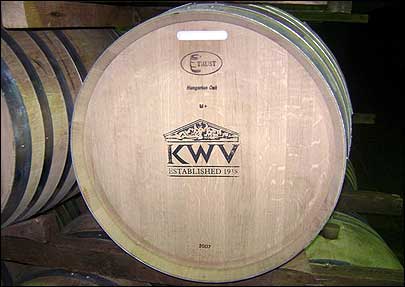KWV is employing RFID technology to track its barrels as they are used to store wine and brandy being processed and aged. The system, provided by RFID Institute and using tags from Alien Technology, helps the South African brandy and wine maker track where its barrels are located, the number of times they have been used and when new barrels need to be ordered.
Barrels are an important asset for wine makers, but until now, KWV has had a difficult time tracking them. The company’s Paarl facility has designated locations, divided into small storage areas, for brandy and wine. The barrels are stored in multiple locations within the two plants as they are used and reused. Utilizing the correct barrels at the proper time during the aging process affects the spirits’ quality, but these oak wooden barrels—which cost about $1,000 apiece—are difficult to track through the maturation process and (in the case of brandy) distillation.
KWV previously used a paper-based system that assigned batch numbers to track groups of barrels as they arrived from coopers in France and the United States. Once a batch of barrels was broken into smaller groups, however, it became very difficult to identify them. This created problems for the company, because the origins and history of each barrel are critical to the brandy- and wine-making business.
A barrel wood’s forest of origin, its wood-grain and age, and the type of wine or brandy it has contained (and for how long) all affect the flavor and quality of the product stored within it. Barrels are reused multiple times over their 20- to 30-year lifespan, but wine makers must track how often, for how long, and with which wine or brandy each has been used, to know how its wood will affect the next mix stored in it.
Barrels are initially filled with wine, which is then aged for several years, at which point KWV determines which wine batches will be distilled as brandy. Brandy requires a longer maturation process—10 or 20 years—as it ages in multiple barrels. A 20-year-old brandy can typically change barrels eight to 10 times to enhance its flavor before being bottled.
After about a year of testing and installing the RFID system under the direction of Hanno Mutton, KWV’s IT department manager, the company began employing it this month to track its barrels. It began by tagging new barrels upon their arrival, says RFID Institute’s senior application engineer, Kevin O’Neill and is currently in the process of tagging all of its approximately 70,000 existing barrels, located in several sites in South Africa.
When KWV requires additional barrels, it places an order with a cooper. As a batch of barrels arrive at KWV’s Paarl facility, they come plastic-wrapped with a paper order listing the details about that batch, such as its wood grain (indicating the oak’s quality) and a batch identification number.
While unwrapping the barrels for use, KMV employees attach an Alien UHF EPC Gen 2 Squiggle tag to each barrel’s face (the front of a barrel when turned on its side), says Stephen Crocker, Alien’s director of sales and channel management in Europe, Middle East and Asia (EMEA) and India. They then utilize a handheld RFID interrogator with a Windows SE-based PDA, designed by RFID Institute, to capture every tag’s unique ID number. At that point, the workers follow prompts on the PDA to indicate the batch number assigned to that barrel, as well as the cooper, the forest from which the barrel’s wood originated, and the wood grain.
This data is then transmitted, via a Wi-Fi connection, directly to the company’s SAP system, where RFID Institute’s Barrel Tracking System software creates a record for each barrel. Throughout the life of the barrel, KWV employees can look up an individual barrel by ID number, prompting a page to appear showing the barrel’s status, as well as when, where and how it has been used, and such background information as the cooper of origin.
Employees store the barrels on racks fitted with RFID tags, to indicate the row and storage-area location numbers. A worker scans just one barrel in a particular batch, as well as the rack RFID tag, and the system then links the entire batch to that specified location.
When the barrels are filled with wine or brandy, the employee again uses the reader to capture just one RFID tag on the nearest barrel, automatically including all of the other barrels within that batch. The worker then inputs his actions to the PDA, such as filling or emptying the barrels, and that information is updated in the SAP system. If a batch of barrels is to be moved, or if some have separated from the rest, there is also a prompt for this action, and the staffer reads the ID number of the tag on each barrel being separated from the batch, associating it with another batch in the barrel’s new location.
To make the system work, O’Neill says, researchers first needed to overcome several readability issues. During a test, for instance, after tagging 500 barrels filled with water, they found they could read the tags—but when they filled the barrels with wine, the tags were no longer readable. According to Crocker, the alcohol content in the wood affects the RF transmission. “We had no reads,” O’Neill says. “We couldn’t believe it.”
RFID Institute resolved the problem by creating a 3-millimeter (0.12-inch) air pocket in the inlay, separating the RFID chip from the barrel itself. Another challenge involved ensuring that the adhesive material, provided by 3M, would comply with South Africa’s health and safety requirements. “Those regulations are very stringent,” O’Neill says.
With the new system, KWV is now able to determine not only where a barrel has been and how it has been used, but also when the company is running short on a specific kind of barrel. In addition, it can locate a certain type of barrel needed for a particular kind of wine or brandy, such as a cycle 2 barrel (one that has already stored two batches of wine).
Although KWV declines to comment on the system, O’Neill says the brandy maker is pleased with the technology as it currently operates. The next phase, he says, is to track bottled brandy and wine as it is shipped to customers. “They want to proceed with tagging cases of wine and brandy,” he states, though he indicates the company does not yet have a timeline for deploying the system. With the new system, he adds, KWV could tag each of the 3 million cases of bottled wine and brandy it ships annually, as well as scan them as they leave the warehouse, enabling automatic advance shipping notification.




